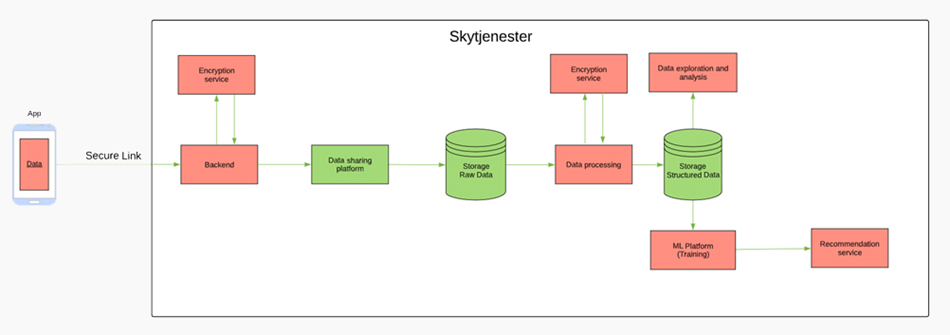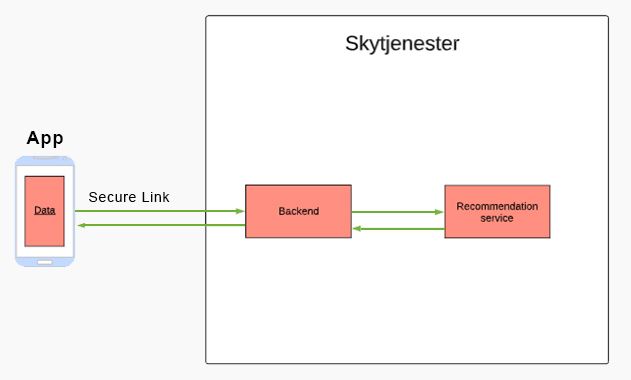About Ruter's project
Ruter is a public enterprise that is owned by the City of Oslo and Viken County Council, which plans, coordinates, orders and markets public transport in those areas. One of Ruter's primary services is the Ruter app, which allows customers to plan trips, view departure times in real time, filter means of transport and purchase tickets.
What is the problem that Ruter wishes to solve?
Ruter is planning a new service that will provide customers with more personalised and specific travel suggestions using artificial intelligence based on their usage history. As of the start of this sandbox project, the solution is in the concept phase.
Ruter emphasises in their strategy documents that the current transport solutions are facing major changes. These changes are driven by a desire for more sustainable solutions, technological development, new business models and changing customer expectations. Ruter needs to adapt to these changes in order to continue to offer a good and stable transport service in the capital city region.
The Ruter app is one of the most important tools for customers when travelling by public transport. A good experience with the app can contribute to higher customer satisfaction. In order for the suggestions to be adequately personalised, Ruter believes that the AI model needs to learn from the customers' personal data.
The development of AI services based on customers' personal data is reliant on their willingness to share their personal data and to trust that Ruter will do a good job of protecting their privacy. Ruter therefore has a clear goal that, together with the personalisation of the digital products, they have to provide clear, understandable and user-friendly information about the services.
Ruter currently finds that they enjoy a high level of trust among customers. Transparency concerning the use of customers' personal data is vital for safeguarding this trust and for encouraging them to use new services. Transparency is also a basic requirement in the data protection regulations when businesses adopt solutions that process personal data.
In this sandbox project, we take a closer look at what requirements are set for transparency when using personal travel information to develop a service that uses AI to provide personalised travel suggestions.
Transparency and explainability
Transparency and explainability have been topics of previous sandbox projects. In the project with the Norwegian Labour and Welfare Administration (NAV), we discussed what a meaningful explanation of AI models looks like and how the explanation needs to be adapted to the intended target group.
Read more in the project’s exit report here
The Norwegian Data Protection Authority has also written a general report on how to succeed with transparency in connection with the use of AI. The report is based on experiences from several previous sandbox projects.
How will Ruter use artificial intelligence?
Ruter wants to use artificial intelligence and machine learning to learn from customers' personal data in order to offer personalised travel suggestions. The travel suggestions will be based both on the customer's own travel patterns, and where others who are located at the same place as the customer typically travel to.
The solution involves three phases:
- During the preparation phase, there must be a function in the Ruter app that collects personal data for the development and training of an AI model. The data will be temporarily stored on the customer's device (client). No development will take place as long as the data is stored on the customer's device. The purpose of the temporary storage is to enable Ruter to collect data points at an earlier stage of the process.
- During the development phase, the personal data will be sent to, stored by and used in Ruter's central systems. The purpose of this is continued development and training of an AI model. The transfer to Ruter's central systems must be based on the consent of customers who are logged-in.
- During the usage phase, the service with personalised travel suggestions will be launched for customers in the Ruter app if they are logged-in and consent to this. The development of the service will continue centrally at Ruter in parallel with the usage phase. Since travel patterns are constantly changing, the solution will be further developed to enable the model to be correct, relevant and up-to-date at all times.
The personal data that will be used is where and when the customer opens the app, the travel searches that are made and location. Previous searches in the app, both by the specific user and other users, will be used to train the AI model to provide better travel suggestions.
In connection with this, we would also mention that Ruter may encounter situations where they process special categories of personal data (also known as sensitive personal data). We will return to this below.
Basic presentation of Ruter's solution during the development and usage phases
Ruter was still in the concept phase of its solution as of the date this report was prepared. Changes may therefore have occurred when Ruter potentially launches the solution.
The development phase:
During the development phase, personal data will be collected for training the AI model. The purpose is to develop an AI model that can generate relevant, good-quality, personalised travel suggestions.
- Ruter registers a selection of the customer's actions in the Ruter app. This includes searches performed and travel suggestions displayed.
- Data relating to the customer's actions is sent to a "back-end" system over an encrypted line, where the customer's identity is replaced with a pseudonymised number.
- The back-end system encrypts the customer's data and sends this to an internal sharing platform.
- Ruter then sends the data to a server where the data is processed and analysed for it to be suitable for further use. The personal data is temporarily decrypted during this processing stage.
- The data is sent to a machine learning platform where the AI model "learns" from the data. The data is decrypted while learning is in progress.
- After the AI model is fully trained and validated, it generates travel suggestions based on the personal data it receives.
Visual presentation of the development phase

Steps two to six in the description are carried out in a cloud service. In the figure illustrating the development phase, data will be encrypted where it is green, while data must be decrypted temporarily in the red components.
As an alternative to the described solution, Ruter is considering carrying out the data flow in the development phase without using a common platform (cf. section 3 above), in addition to changing how the data is to be encrypted.
The development phase will be ongoing, because the AI model will need to continuously collect new information in order to learn and improve its travel suggestions.
Usage phase:
During the usage phase, personal data will be used to predict travel wishes and retrain the AI model. The purpose of data processing in the usage phase is to generate personalised travel suggestions in the Ruter app.
- Customers open the Ruter app when planning a trip.
- The app sends a request to the back-end system with the user's location. The customer's identity is replaced with a pseudonymised number before it is forwarded on.
- The AI model sends travel suggestions back to the back-end system based on where the customer was and when the request was sent to the back-end system.
- The back-end system sends the travel suggestion to the Ruter app, where the suggestion is presented to the customer.
- The personal data (pseudonymised) is both stored in the back-end system and used for training the AI model.
Visual presentation of the usage phase
